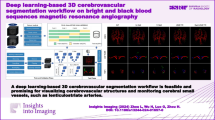Abstract
The extraction of cerebrovascular structure plays a pivotal role in the diagnosis and analysis of various cerebrovascular diseases. However, cerebrovascular segmentation from time-of-flight magnetic resonance angiography (TOF-MRA) volumes remains a challenging task due to the complex topology, slender contour, and noisy background. This paper proposes a 3D SS-Net that combines the spatial and spectral domain features to accurately segment the cerebral vasculature. The SS-Net is based on an end-to-end autoencoder architecture, which incorporates both spatial and a spectral encoders. The spectral encoder branch applies 3D fast Fourier convolution (FFC) to extract global features and frequency domain features in the shallow layers of the network. Furthermore, we introduce cerebrovascular edge supervised information, which enables the network to model the high-frequency variations and distribution patterns of cerebrovascular edges more effectively. Experimental results show that the SS-Net delivers outstanding performance, achieving the DSC of 71.14% on a publicly available dataset and outperforming other 3D deep-learning-based approaches. Code: github.com/y8421036/SS-Net.
Access this chapter
Tax calculation will be finalised at checkout
Purchases are for personal use only
Similar content being viewed by others
References
Banerjee, S., Toumpanakis, D., Dhara, A.K., Wikström, J., Strand, R.: Topology-aware learning for volumetric cerebrovascular segmentation. In: 2022 IEEE 19th International Symposium on Biomedical Imaging, pp. 1–4 (2022). https://doi.org/10.1109/ISBI52829.2022.9761429
Cetin, S., Demir, A., Yezzi, A., Degertekin, M., Unal, G.: Vessel tractography using an intensity based tensor model with branch detection. IEEE Trans. Med. Imaging 32(2), 348–363 (2013). https://doi.org/10.1109/TMI.2012.2227118
Chen, Z., et al.: Generative adversarial network based cerebrovascular segmentation for time-of-flight magnetic resonance angiography image. Neurocomputing 488, 657–668 (2022)
Chi, L., Jiang, B., Mu, Y.: Fast fourier convolution. In: Larochelle, H., Ranzato, M., Hadsell, R., Balcan, M., Lin, H. (eds.) Advances in Neural Information Processing Systems, vol. 33, pp. 4479–4488. Curran Associates, Inc. (2020)
Çiçek, Ö., Abdulkadir, A., Lienkamp, S.S., Brox, T., Ronneberger, O.: 3D U-Net: learning dense volumetric segmentation from sparse annotation. In: Ourselin, S., Joskowicz, L., Sabuncu, M.R., Unal, G., Wells, W. (eds.) MICCAI 2016. LNCS, vol. 9901, pp. 424–432. Springer, Cham (2016). https://doi.org/10.1007/978-3-319-46723-8_49
Farshad, A., Yeganeh, Y., Gehlbach, P., Navab, N.: Y-net: a spatiospectral dual-encoder network for medical image segmentation. In: Wang, L., Dou, Q., Fletcher, P.T., Speidel, S., Li, S. (eds.) MICCAI 2022. LNCS, vol. 13432, pp. 582–592. Springer, Cham (2022). https://doi.org/10.1007/978-3-031-16434-7_56
Frangi, A.F., Niessen, W.J., Vincken, K.L., Viergever, M.A.: Muliscale vessel enhancement filtering. In: International Conference on Medical Image Computing and Computer-Assisted Intervention (1998)
Han, H., et al.: Reduction of cerebral blood flow in community-based adults with subclinical cerebrovascular atherosclerosis: a 3.0T magnetic resonance imaging study. NeuroImage 188, 302–308 (2019). https://doi.org/10.1016/j.neuroimage.2018.12.021
Jenkinson, M., Pechaud, M., Smith, S., et al.: BET2: MR-based estimation of brain, skull and scalp surfaces. In: Eleventh Annual Meeting of the Organization for Human Brain Mapping, Toronto, vol. 17, p. 167 (2005)
Liao, W., Rohr, K., Wörz, S.: Globally optimal curvature-regularized fast marching for vessel segmentation. In: Mori, K., Sakuma, I., Sato, Y., Barillot, C., Navab, N. (eds.) MICCAI 2013. LNCS, vol. 8149, pp. 550–557. Springer, Heidelberg (2013). https://doi.org/10.1007/978-3-642-40811-3_69
Milletari, F., Navab, N., Ahmadi, S.A.: V-net: fully convolutional neural networks for volumetric medical image segmentation. In: 2016 Fourth International Conference on 3D Vision, pp. 565–571. IEEE (2016)
Mou, L., et al.: CS2-Net: deep learning segmentation of curvilinear structures in medical imaging. Med. Image Anal. 67, 101874 (2021)
Phellan, R., Peixinho, A., Falcão, A., Forkert, N.D.: Vascular segmentation in TOF MRA images of the brain using a deep convolutional neural network. In: Cardoso, M.J., et al. (eds.) LABELS/CVII/STENT -2017. LNCS, vol. 10552, pp. 39–46. Springer, Cham (2017). https://doi.org/10.1007/978-3-319-67534-3_5
Sanchesa, P., Meyer, C., Vigon, V., Naegel, B.: Cerebrovascular network segmentation of mra images with deep learning. In: 2019 IEEE 16th International Symposium on Biomedical Imaging, pp. 768–771. IEEE (2019)
Suvorov, R., et al.: Resolution-robust large mask inpainting with fourier convolutions. In: 2022 IEEE/CVF Winter Conference on Applications of Computer Vision, pp. 3172–3182 (2022). https://doi.org/10.1109/WACV51458.2022.00323
Szegedy, C., Ioffe, S., Vanhoucke, V., Alemi, A.A.: Inception-v4, inception-resnet and the impact of residual connections on learning. In: Thirty-First AAAI Conference on Artificial Intelligence (2017)
Wang, Y., et al.: JointVesselNet: joint volume-projection convolutional embedding networks for 3D cerebrovascular segmentation. In: Martel, A.L., et al. (eds.) MICCAI 2020. LNCS, vol. 12266, pp. 106–116. Springer, Cham (2020). https://doi.org/10.1007/978-3-030-59725-2_11
Yang, X., Cheng, K.T., Chien, A.: Geodesic active contours with adaptive configuration for cerebral vessel and aneurysm segmentation. In: 2014 22nd International Conference on Pattern Recognition, pp. 3209–3214 (2014). https://doi.org/10.1109/ICPR.2014.553
Zhang, H., et al.: Context encoding for semantic segmentation. In: Proceedings of the IEEE Conference on Computer Vision and Pattern Recognition, pp. 7151–7160 (2018)
Zhang, H., et al.: Cerebrovascular segmentation in MRA via reverse edge attention network. In: Martel, A.L., et al. (eds.) MICCAI 2020. LNCS, vol. 12266, pp. 66–75. Springer, Cham (2020). https://doi.org/10.1007/978-3-030-59725-2_7
Zhao, Y., et al.: Automatic 2-D/3-D vessel enhancement in multiple modality images using a weighted symmetry filter. IEEE Trans. Med. Imaging 37(2), 438–450 (2018). https://doi.org/10.1109/TMI.2017.2756073
Zhou, S., et al.: Statistical intensity- and shape-modeling to automate cerebrovascular segmentation from TOF-MRA data. In: Shen, D., et al. (eds.) MICCAI 2019. LNCS, vol. 11765, pp. 164–172. Springer, Cham (2019). https://doi.org/10.1007/978-3-030-32245-8_19
Acknowledgements
This work is partly supported by National Key R &D Program of China (Grant no. 2019YFF0301800), National Natural Science Foundation of China (Grant no. 61379106, 61806199), the General Research Projects of Beijing Educations Committee in China (Grant no. KM201910005013), the Shandong Provincial Natural Science Foundation (Grant nos. ZR2015FM011).
Author information
Authors and Affiliations
Corresponding author
Editor information
Editors and Affiliations
Rights and permissions
Copyright information
© 2023 The Author(s), under exclusive license to Springer Nature Switzerland AG
About this paper
Cite this paper
Yang, C. et al. (2023). SS-Net: 3D Spatial-Spectral Network for Cerebrovascular Segmentation in TOF-MRA. In: Iliadis, L., Papaleonidas, A., Angelov, P., Jayne, C. (eds) Artificial Neural Networks and Machine Learning – ICANN 2023. ICANN 2023. Lecture Notes in Computer Science, vol 14256. Springer, Cham. https://doi.org/10.1007/978-3-031-44213-1_13
Download citation
DOI: https://doi.org/10.1007/978-3-031-44213-1_13
Published:
Publisher Name: Springer, Cham
Print ISBN: 978-3-031-44212-4
Online ISBN: 978-3-031-44213-1
eBook Packages: Computer ScienceComputer Science (R0)




